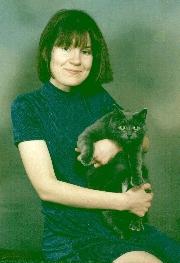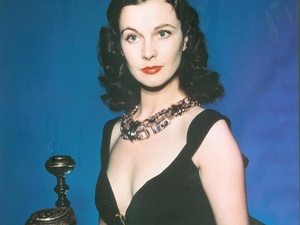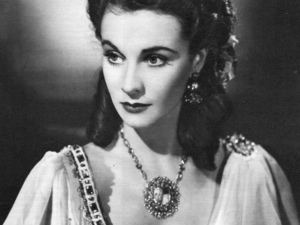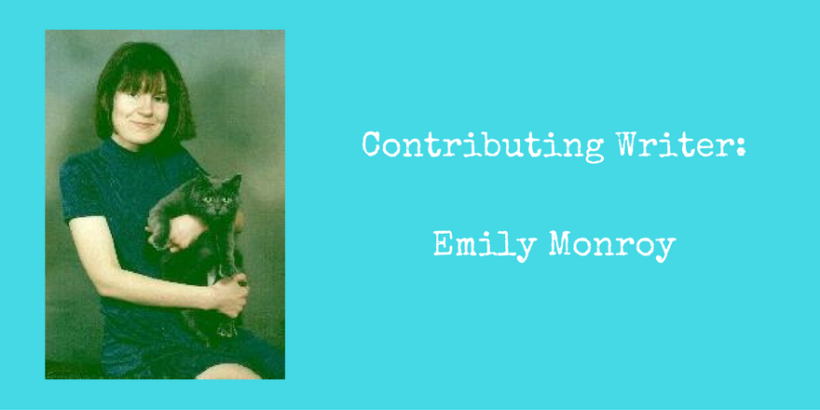Vivien Leigh, Anglo-Indian?
by Emily Monroy
August/September 2015

Last December marked the 75th anniversary of the movie Gone with the Wind. The film, like the historical novel by Margaret Mitchell on which it was based, has generated a wide range of reactions over the years. A (White) teacher of mine in high school called Gone with the Wind the best movie ever made. On the other hand, my mother (also White) happened to chance upon the film as she was flicking through the channels on her TV and remarked to me, ‘It really was a racist movie,’ echoing a criticism often voiced against Gone with the Wind.
To be fair, Gone with the Wind was not The Birth of a Nation. Rather, ‘Negroes,’ the polite word by which Blacks were known then, were portrayed in the former film as good people as long as they knew their place, which happened to be slavery before the Civil War and serving in the O’Hara household afterwards. Even the bumbling slave girl Prissy (‘I don’t know nothin’ ‘bout birthin’ babies’) comes across as more or less benign; she, after all, isn’t clamouring for freedom or joining the Yankees.
It might come as a surprise, therefore, that Vivien Leigh, the actress who played the main character Scarlett O’Hara, may not have been purely ‘White’ as we understand the term. Although Leigh is generally described as British, she may actually have been part-Indian, from India.

Vivien Leigh was born Vivian Mary Hartley in Darjeeling, India, at a time when that country was under British rule. Her father was from Britain itself (Yorkshire), but her mother’s origins are more mysterious. Leigh’s maternal grandmother is believed to have been Irish; her Catholic religion seems to suggest this (statements that Vivien Leigh was half-French were in all probability fictitious, part of a ruse to make her further resemble the character she played in Gone with the Wind). Her maternal grandfather’s surname is given as Yackjee, which is thought to be an Indian name. Vivien Leigh may therefore have been an Anglo-Indian.
Who are the Anglo-Indians? Anglo-Indians are people of mixed Indian and European background who, as a group, arose during India’s days as a European colony. Anglo-Indians’ European ancestry generally hailed from England itself, but some Anglo-Indians had forbears from other European countries that ruled (parts of) India, such as Portugal and the Netherlands, while others descended from Europeans who came to India along with the English, like the Irish. Most first-generation Anglo-Indians were born to White fathers and South Asian mothers rather than the opposite combination. In time, however, Anglo-Indians became a community in their own right, marrying within their group and distinguishing themselves from the Indian majority around them in areas like language (usually English) and religion (Christianity, mainly Catholicism or Anglicanism).
In many ways, the Anglo-Indians resembled other mixed communities in Asia, such as mestizos in the Philippines, Indos in Indonesia, and Anglo-Burmese in what is now Myanmar. Like the Anglo-Indians, these groups were born mostly from unions of European men and Asian women. They too tended to adopt the language and culture of their paternal as opposed to maternal ancestors. However, because Europeans were never a large numerical presence in Asia, mixed White-Asian communities were always a small percentage of the population in the countries in which they lived. Hence they did not have much influence on these nations as a whole. This was quite a different situation from that of the mestizos of Latin America, who eventually became the majority of that region’s population and brought it into the Western fold (I discuss this in my previous essay ‘Race Mixing and Westernization in Latin America and the Philippines.’)
Anglo-Indians largely ceased to be a distinct community in India when that nation gained independence from Britain in the 1940s. Some historians theorize that being so much more European than South Asian in culture, Anglo-Indians felt they no longer had a place in a country that had broken off from the so-called motherland. Therefore, many Anglo-Indians left India, going to the United Kingdom itself or to Commonwealth countries like Australia and Canada. Some famous Anglo-Indians include comedian Russell Peters and singer Engelbert Humperdinck (not to be confused with the German composer of the opera Hansel and Gretel; the singer’s name was a pseudonym of George Dorsey).

Going back to Vivien Leigh, the idea that the woman who played Scarlett O’Hara may not have been 100% White puts her role in Gone with the Wind in a different perspective. I know that, contrary to the beliefs of left- and right-wing ideologues alike, different minority groups do not necessarily love each other. I also know that relations between Blacks and South Asians have not always been easy, whether in Uganda under Idi Amin, in places with large numbers of both groups like Guyana or Trinidad and Tobago, and even in industrialized countries such as Britain or Canada. It is not even that Vivien Leigh’s performance as the slave mistress who beats Prissy with a tree branch is less convincing. However, I do think it places my mother’s description of Gone with the Wind as racist (i.e., in this case White Supremacist) in another light.
Another question: if Vivien Leigh was actually of mixed race, did that help her career in terms of the roles she received? She portrayed characters of various ethnicities, from (French or part-French) Southern belles like Scarlett O’Hara and Blanche DuBois in A Streetcar Named Desire to the title character in Anna Karenina (Russian) to Cleopatra (Egyptian of Greek origin) in Caesar and Cleopatra. Was Vivien Leigh perhaps a bit like Anthony Quinn (of Mexican and Irish descent), who managed to play a culturally diverse repertoire of characters? These are the many questions raised by Vivien Leigh, Anglo-Indian (?).
Emily Monroy is a professional translator and is of Irish, Italian and Norwegian descent. Born in Windsor, Ontario, she now resides in Toronto. Her articles have appeared in several publications, including Interracial Voice, Cats Canada, and Urban Mozaik. She welcomes feedback on her articles. You can contact Emily here


Anglo Indian implies that they are of British descent and born or have spent time in India; the version you are using is the post-colonial meaning. Also her mother’s maiden name was Robinson the other was the surname of her adopted family.
You are wrong…. her mother sometimes used her mother’s surname of Robinson… the name of Yackjee was her fathers… VL was and always will be an anglo indian… it is in all the records in India.. even the school she attended in India… nothing to be ashamed of.
Yackjee is Armenian. The family traveled through India
My great grandpa was Yackjee and he was Indian with Portuguese decent on his Mother side
I say that with respect not meant to offend .
I am of Indian origin and very proud of its Ancient History and its contribution to the World . From Surgery , Philosophy, Science , Maths and Literature.
We are all victims of history – the make belief that the British religion , culture was vastly superior to anything
Asian , Arabic , African etc …
And the Anglo Indians chose the easier way , to associate themselves with that culture .
Now Whats so great about being Armenian ? Seriously?
What did they contribute to the World – in fact they were mostly of Iranian stock and acknowledged Christianity .
Even Lady Dianas ancestors were ”armenians ” – this is proven wrong . They were Indians probably hindus .
Now Do you know any Armenian called Yackjee ?
That sounds very Sindhi , Gujrati .. These are people with a fascinating history .
Why are you not proud of your Indian heritage ?
PS : I am not trying to force my ideas upon you .
I’m happy to be an Anglo Indian from 4 generations of mixed blood. However in those days many fair ones denied their heritage like Vivien Leigh, Cliff Richard, Englebert Humperdink to get ahead in the racist world of showbiz.
Why don’t you post your picture for us to see ?
JI or JEE s Always Indian. Ending in IIAN is Armenian. Why do Armenians always Claim ancestry, surprisingly in India!!
True They are ashamed or either jealous
Viven’s mother’s maiden name was Yackjee. The name Robinson was Vivien’s maternal grandmother. Originally Anglo-Indian referred to British/English people who lived in India. Later on it included those born of mixed-parentage.
I am Anglo Indian, my father looks very Indian but his father less so. We’re generations mixed race. At any rate, I was 5 when I first saw gwtw and being told at the time of the rumor of Ms Leigh’s racial background stuck with me. I’m as white as she is so it’s possible. I am immensely proud to be mixed race regardless of my skin colour. The possible racial dimension and the idea she is ‘passing’ (terminology of the time) does add something to the film for me.
i doubt you are white
Well, I don’t doubt that Elaine is white skinned.
I’m from a white skinned French father and a brown skinned Indian mother. I am myself as white as a brioche, with freckles and brown hair. My elder sister is white like me, my younger sister is brown skinned like my mom.
Mixed people come in all carnations, darkest to lightest skin and everything in between, even in one same family.
Like Elaine, I am also very happy to carry my unique heritage with me. My grandad was from Orissa and my grandma was Anglo-indian raised in Burma. As a mixed race person with a “white passing” I have learned that people are way more complex than just their birthplace gives out, and that skintone certainly doesn’t tell you what a person’s ethnic heritage is.
Love to all 💖🦄
Naomi Scott who is Princess Jasmine in Aladdin is British Father and Indian Mother and look at her same with Merle Oberon from Wuthering Heights
If you see my daughter and my niece you will see Vivian Leigh face
As if being white is something to yearn for -you think Europeans are all Caucasians ?
No – Hungarians are Turkish mongols ( magyars ) , Bulgarians- bulgars —- turks , Rumanians a little bit of everything , the French : mixed with the goths , Alans ( turk Iranians ) , Moors in many areas of Provence , Spain and Portugal with their Moorish features plus the assimilation of the African slaves ( where are they now ?)
And Russians – No comments . The Jews of Khazastan …. also assimilated ..
So there is a Grey zone with Whiteness .
No offence meant to anybody. Be proud of who you are .
Why are you so defensive for heavens sake.
Armenian, not Indian
Indian
Thank you for the comments. To Aurelus, would not Vivien Leigh qualify, under your terms, as Anglo-Indian?
Yes she is part Indian and also there is another famous actress Merl Oberon
she was armenian
My great great grandparents are from India their last name was Yackjee just so very kind coincidental
I have lots of relatives who are half white they look all white because our features a sauce similar we have straight nose slender lips soft hair for the children white or either Spanish some people think they are Italian
I live in Switzerland and had an old Anglo Indian friend, Charlie Matthews, who passed away a few years ago. He was related to Vivien Leigh’s mother and had told me she was Anglo Indian with an Armenian background too. Here in Switzerland we have many Indians married to Swiss and their children are all white skinned or blond with blue eyes. After one generation they mix with the local Europeans. Just take a look at the Indian bollywood stars like Karisma Kapoor or he sister Kareena Kapoor, who are the grand-daughters of Raj Kapoor. All their family members were white and Raj Kapoor even had blue eyes but they were pure Indian and Hindu. There are also actresses like Evelyne Sharma (Indian father, German mother), and several others who are of mixed race and are absolutely white and very beautiful. Precisely the Indian mixture gives them beautiful, fine features. The geographic region also determines the looks in India – we have all colours in India. Most Pakistanis from the northern part of Punjab are blond haired and blue eyed as compared to the dark races of South India. You even find the Asian race in East India where they look Chinese or Japanese.
Vivien Leigh is from the ethnic minority Anglo Indians. We have European names as the Male names were so during Colonial times. Hollywood was racist and Jews and some ethnicities if could pass as white denied their backgrounds to be employed as with singers like Cliff Richard. His tan is permanent. Mixed races vary in colour tones from dark to light.
Very very true Merl Oberon from weathering Heights her mother was Indian her father was white and British aristocrat but he was going to marry her mom but he died but she was very ashamed to see her mother was Indian she passed her mother off as a maid because it would like a chance of becoming popular
I am Indian originally from Trinidad my parents grandparents had Portuguese an out of mixture as well but I am dark skin brown skin but my features are like a white person very straight small nose slender lips it’s just I’m a dark white person basically my hair is like white people hair soft straight I have a nice many many relatives close relatives who are married to white their children look white because of our features
The children are albinos because they carry the P gene mutation from the dark races.
Why are you obsessed with having white features. It was all colonialism and marrying white means the self hatred your family presumably carry and probably so cause people who live in former colonial nations have vast amounts of self hatred and you hype up any whiteness you have in your face without realising the dark history behind it.
lmao no she was to stunning to be indian
Oh, so you actually ARE a troll. You poor thing, here have some love 💖💗💖💗💖 and a wonderful day.
Have you ever googled Indian movie stars in India they are pink skin beautiful natural eyebrows and eyelashes street knows flawless complexion’s they are called the upper cast they do not even mingle with the Lord cast Indians were dark skin
Very very true Merl Oberon from weathering Heights her mother was Indian her father was white and British aristocrat but he was going to marry her mom but he died but she was very ashamed to see her mother was Indian she passed her mother off as a maid because it would like a chance of becoming popular
I am Indian origin from Caribbean my parents grandparents had Portuguese an out of mixture as well but I am dark skin brown skin but my features are like a white person very straight small nose slender lips it’s just I’m a dark white person basically my hair is like white people hair soft straight I have a nice many many relatives close relatives who are married to white their children look white because of our features
Not a British Aristocrat at all. A soldier. All made up. Merle was ashamed of her mother and background.
Google Prince William and Lady Diana google all you like they have Indian heritage
There are plenty of Indian actresses I would consider more beautiful than Miss Leigh. Tastes are subjective of course but what a ridiculous and scornful comment.
Why don’t you post your picture for us to see ?
I am Anglo Indian, my great grandfather was Scottish, and he went to India to join the British army, this was on My Fathers side. On my Mother’s side her great grandfather was Austrian /German and he married an Indian my great great grandmother. My Dad’s father married my grandmother who was Burmese. My Grandfather and my Father were very fair skinned, but my mother had a tanned complexion, my sister has a lighter complexion than me I am more dark skinned. I am proud to be an Anglo Indian we were brought up speaking English only, I went to a Boarding School in Mumbai which is still going strong and one the best schools in Mumbai, the name is The Bombay Scottish high School, I was even baptised in the Scots Kirk Church which is Protestant. We were brought up in two worlds Indian and British and made us more accepting of both worlds. Always be proud of who you are. Donald Mobsby
I am Anglo Indian, my great grandfather was Scottish, and he went to India to join the British army, this was on My Fathers side. On my Mother’s side her great grandfather was Austrian /German and he married an Indian my great great grandmother. My Dad’s father married my grandmother who was Burmese. My Grandfather and my Father were very fair skinned, but my mother had a tanned complexion, my sister has a lighter complexion than me I am more dark skinned. I am proud to be an Anglo Indian we were brought up speaking English only, I went to a Boarding School in Mumbai which is still going strong and one the best schools in Mumbai, the name is The Bombay Scottish high School, I was even baptised in the Scots Kirk Church which is Protestant. We were brought up in two worlds Indian and British and made us more accepting of both worlds. Always be proud of who you are. Donald Mobsby
Thank you, Donald. You have a very interesting family history. Here in Canada, there is a well-known comedian of Anglo-Indian descent called Russell Peters. Of course just seeing the name you would think he was your ordinary Anglo-Canadian, but he explained he is of Anglo-Indian descent. Culturally, Anglo-Indians are very European. As you said about yourself, they speak English as a first language, and most are Christian (Catholic, Anglican or, in your case, Presbyterian). I also see you use British rather than American spelling (“baptise” instead of “baptize”).
However, my impression is that Anglo-Indians only make up a small proportion of the Indian population. Also, unlike the Spanish in the Philippines, for example, the British never imposed their religion on India, so Indians as a whole did not embrace Christianity as the Filipinos did. That is not to say that British rule had no effect at all on India, but India never became a “New England,” so to speak, or “Britain’s offshore farm” (used to describe New Zealand). So that makes Anglo-Indians even more unique.
Also, as your own history shows, some of the “Anglos” were not only English but Scottish (or in Leigh’s case, Irish). I suppose by “Scots Kirk” you mean what in North American is referred to as Presbyterian. In the Old World, it’s known as the “Church of Scotland” (it made news when back in the late 1980s, Princess Anne got remarried in the Church of Scotland rather than Church of England because the Anglican Church didn’t permit divorce; things have obviously changed since then).
I have the impression that after India became independent of Britain, a lot of Anglo-Indians left India and went elsewhere, generally English-speaking countries, including Canada. However, except for Peters (whom I don’t know personally), I’ve never heard of any other Anglo-Indians in Canada. I wonder if they would gravitate toward the Indian community or simply blend into the general Anglo population.
Armenian! Do me a favour! A lot of Anglo-Indians would go to any lengths to deny their Indian heritage, I know this because my paternal grandparents were Anglo-Indian (mixed European and Indian ancestry). It was instilled into them that they were “British” through and through (which I don’t think was necessarily a bad thing, judging by the state of the UK today).
Hi! Thank you for everyone who has responded. I am sorry; I have been unwell for the last while (well, I had a stroke in 2009 which basically destroyed my short-term memory; I’ve been working since on recovering), so I am happy people are still reading my articles.
I met a very nice gentleman the other day from India who told me he had a great-grandfather from Ireland who was working in India during the British rule. He himself had a Portuguese-sounding last name (he must have been from Goa, which was at one time a Portuguese colony). He had an Irish breed of dog, a Wheaten terrier, which is popular even among non-Irish people because of its good nature and the fact it doesn’t shed hair. This man recommended that my niece, who lives in England with her parents and is just about to graduate from high school, consider continuing her education at the University of Dublin. Of course this man was biased, but I’ve heard good things about Ireland’s educational system even from non-Irish people.
Just a note: even if Miss Leigh made her fortune in the United States, I get the impression that many Anglo-Indians leaving India liked to go to Commonwealth countries like Canada and Australia because they were more “British” than the US (even though my own Canada is rapidly losing its Britishness due to our proximity to the US). Any opinions from readers?
What I do know about America is that the film production code had limited opportunities for people who had nonwhite ancestry. Merle Oberon and Vivian Leigh wouldn’t have been cast as romantic heroines if they didn’t present as white.